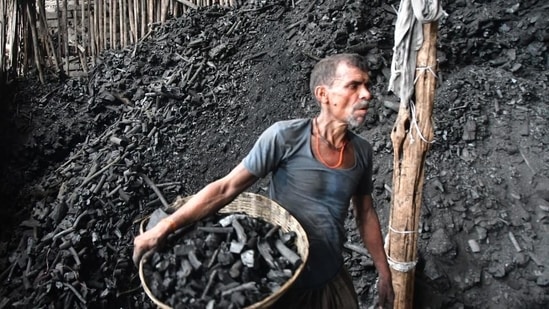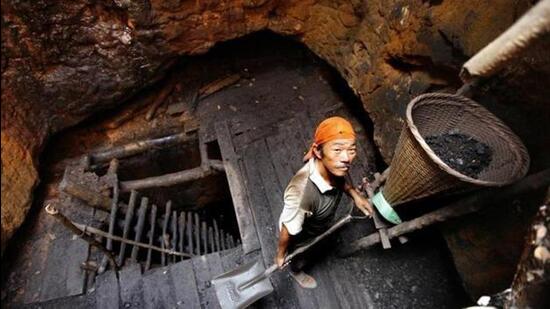Premium Conversations | India's coal phase-down, with Pradip Swarnakar, JTRC
Swarnakar, who heads the Just Transition Research Centre, spoke to HT about how 15-20 million livelihoods are likely to be affected, what should drive India's coal phase-down, and how to protect workers during the energy transition.
New Delhi: The Centre has said, more than once, that India will not phase out coal but it will phase down coal and move towards renewable energy. The coal ministry had informed the Rajya Sabha in March that the energy transition away from coal will not happen in the “foreseeable future” in India. 
But, the Just Transition Research Centre (JTRC) at Indian Institute of Technology (IIT) Kanpur which entered into a partnership with the United States (US)-based Center for Strategic and International Studies (CSIS) earlier this month is already working with the coal unions and industry nationally, and with the West Bengal and Uttar Pradesh governments, in particular, to help them create “just transition” plans for their mines and thermal power plants. The energy transition is inevitable given global climate negotiations, researchers said.

At the Glasgow climate conference (COP 26) last year, South Africa had made headway in the energy transition by getting the European Union, the United Kingdom (UK), France, Germany, and the US to agree to support South Africa’s transition with $8.5 billion. JTRC researchers are also working closely with coal areas of South Africa and the US apart from India.
Pradip Swarnakar, professor at JTRC, who heads the just transition research, said large scale energy transition is likely to happen in India in the next 10-15 years affecting 10-15 million livelihoods.
Excerpts from the interview:
How will energy transition affect livelihoods in India? Any estimates of the number of people who may be impacted and by when?
When we talk of coal regions of the country, we find deep-rooted, singular dependence on the coal sector. So, the immediate and direct impact will be felt by the workers who are directly or indirectly employed in the sector due to the lack of economic diversification in the coal region. These people have worked in that same sector for generations and have a sense of job and place attachment. Therefore, we will also have to consider the psychological cost of uprooting them from their familiar environment.
Somewhere between 15-20 million, including formal, informal and induced workers, are likely to be affected by the coal phase down.
The retraining and reskilling programmes will have to take this into account to be effective and just. The process is complex, and historically we have not seen much success in resettlement and rehabilitation. Apart from those who are directly employed, those running small businesses whose livelihoods depend on the communities established due to coal sectors will also be affected. With the decline, there is a possibility that they may be overlooked in the effort to ensure just transition. It’s difficult to give an estimate for the number of people’s livelihoods getting affected due to a large number of informal workers involved in the sector.
Somewhere between 15-20 million, including formal, informal and induced workers, are likely to be affected.
Do you see the energy transition happening in India? Could you give a few examples?
This is a tricky question. The answer is yes and no. If we think transition means moving from point A to point B, we are not actually moving from point A, but making point B more favourable for the transition. With energy security at the heart of India’s international energy and climate negotiations, the country has resisted any effort from the international community to phase out coal.
Domestically, this resistance reflects in the fact that we don’t have any institutionalised policy framework driving the energy transition. Suppose we understand energy transition in terms of phasing out mines and thermal power plants. In that case, it is difficult to attribute any of the mine or thermal plant closure directly to the energy transition. The closure has been partly due to environmental or low efficiency.

However, we also see a growing discussion on just transition, often supported by governmental departments. Civil society and research organisations are increasingly participating in formulating evidence-based knowledge and discourse around just transition, reflecting a growing awareness and legitimacy for the transition process.
In Indian terms, we can conceive just transition as future planning so that when transition gains pace in India, the coal communities are resilient to its adverse impacts.
The government has said coal consumption will increase in India in the coming years before falling. How will that impact just transition?
As per my understanding, the planned coal expansion would mean creating further economic and social dependency on coal. The expansion would mean more people employed and additional resources committed to the sector, eventually leading to added complications for the transition process. Planning for a just transition is a long-term process. We have already started thinking about a just transition in India which is expected to happen some 10-15 years from now.
If we are to protect the livelihoods of the coal communities, then we will need to provide them with multiple options for ensuring their economic and social security.
Given India’s vulnerability, this has to happen if we are to ensure a sustainable future for the country. In this context, when we think of additional coal capacity being added, the biggest problem we will encounter is a lack of time to plan for a just closure. First, it would mean reskilling a large number of people in a short period. These expanded units will mean new coal communities emerging, and they will also have to be economically and socially rehabilitated. In addition to time, we will face some natural constraints while environmentally restoring the used land and infrastructure.
How can the livelihoods of people working in coal be protected? Can they shift to the renewable energy industry?
The renewable energy sector will not be able to absorb all the workers currently employed in the coal sector. This is partly because renewables are coming up in different geographical regions than coal-bearing states. Consequently, reskilling for the new jobs will be extremely challenging, even if some of the coal workers intend to.
That is why the most agreeable answer tthe o your first question is the economic diversification of the current coal-dependent regions. If we are to protect the livelihoods of the coal communities, then we will need to provide them with multiple options for ensuring their economic and social security. Second, economic diversification automatically leads to questions around reskilling and retraining of workers.
This process will have to be nuanced, considering the components like gender, age, educational qualifications, etc. Here, the efforts will have to be directed towards local and sustainable job creation and a resilient social ecosystem. Third, the coal regions have been bearing an inequitable brunt of environmental degradation and, consequently, poor health. Ecological restoration of the coal infrastructure will also have to be at the heart of the just transition narrative and eventually be strongly integrated into the policy framework.
Lastly, all these efforts will need a nuanced thought into financial and resource allocation. How will the resources be mobilised? How much is needed? Where will it be allocated? Answering these questions requires bringing together the top-down and bottom-up approaches to initiate multi-stakeholder, inclusive, deliberative processes. The collaboration between JTRC and the Center for Strategic and International Studies (CSIS) signifies this coming together of grassroots and top-down voices.
Ecological restoration of the coal infrastructure will also have to be at the heart of the just transition narrative and eventually be strongly integrated into the policy framework.
How will IIT Kanpur’s Just Transition Research Centre (JTRC) collaborate with the CSIS?
The two centres are collaborating to organise several workshops across various states in India. These workshops aim to bring together multiple stakeholders engaged at various levels of policymaking in India, South Africa and the United States for a constructive dialogue. The workshops highlight the need to drive an inclusive and effective discourse around energy transition. Both the centres will synergise their resources for a seamless organisation of these workshops.
Experience unrestricted digital access with HT Premium





